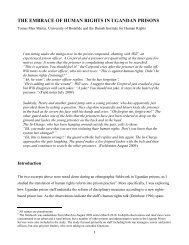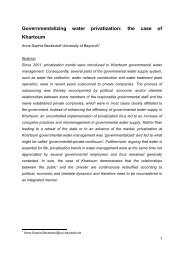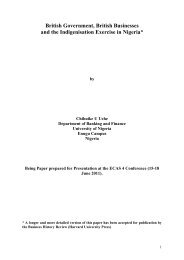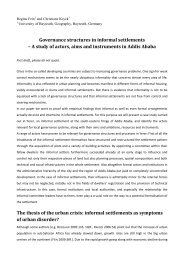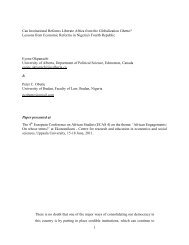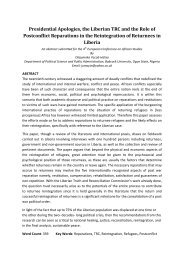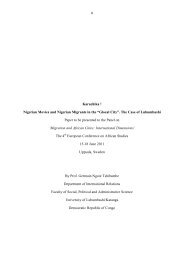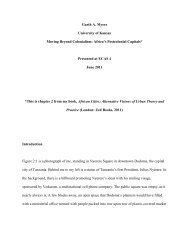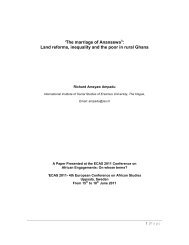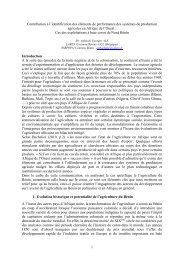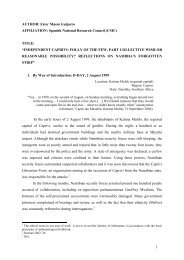Roseline Munwang'o Achieng' - Full paper - The Nordic Africa Institute
Roseline Munwang'o Achieng' - Full paper - The Nordic Africa Institute
Roseline Munwang'o Achieng' - Full paper - The Nordic Africa Institute
Create successful ePaper yourself
Turn your PDF publications into a flip-book with our unique Google optimized e-Paper software.
Building Bridges: Changing the Meaning of Places as Spaces for Human Security<br />
A Paper Presentation by: Dr. <strong>Roseline</strong> M. Achieng‟<br />
Monash South <strong>Africa</strong><br />
A Campus of Monash University – Australia<br />
roseline.achieng@monash.edu<br />
Presented to: Panel 47<br />
From Wars of the Weak to Strong Peace: Issues of Peacemaking<br />
and Peacebuilding in <strong>Africa</strong><br />
Panel Organiser: Prof. Thomas Ohlson (Uppsala University – Sweden)<br />
thomas.ohlson@pcr.uu.se<br />
Conference Title ECAS 2011 – 4 th European Conference on <strong>Africa</strong>n Studies<br />
Uppsala 15-18 June 2011<br />
1
Abstract<br />
Building Bridges: Mechanisms of Trans-local and Gender Cooperation in Changing the Meaning of Places<br />
as Spaces for Human Security is the reworked title of my forthcoming book, which is based on my Ph.D.<br />
<strong>The</strong>sis 1 . In the write-up, I analysed how, despite violent conflicts of an ethnic orientation, spurred by<br />
ruthless political power garnering, through their agency, social groups from different ethnic backgrounds<br />
formulate mechanisms for making peace. <strong>The</strong>se mechanisms, which I conceptualized as trans-local and<br />
gender cooperation at different levels, have enabled groups achieve a level of security and engage in both<br />
political and social economic activities.<br />
However, the question that begs a deeper analysis is, why at the advent of political power garnering, these<br />
socially embedded peace making efforts are abandoned and groups fall into a new state of conflict?<br />
Conceptually, the question is why is it that such socially embedded mechanisms for making peace have not<br />
translated to a strong in built peace that offsets the divisive capacities emergent when politicians contest for<br />
political power and representation?<br />
Contextualising this conceptual analysis in the Rift Valley Province of Kenya, an area that has witnessed<br />
violent conflicts of an ethnic nature with each consecutive national elections and analyzing land as a<br />
contested entitlement, I will argue from the premise that for socially embedded mechanisms of peace<br />
making to translate to strong peace building mechanisms, a civic consciousness that we all belong despite<br />
our ethnic differences has to be nurtured. I conceptualise this as political ethnic pluralism. Secondly, the<br />
issue of entitlement and mechanisms for sharing and redistribution of these is critical. Thirdly, how third<br />
parties, be they civil society groups, UN bodies, or third sector groups can come in and contribute to further<br />
enhance the strong sense of peace building in a community making peace with itself will be explored.<br />
Key Words<br />
Security, political ethnic pluralism, civic consciousness, redistributive justice, translocal gender and ethnic<br />
cooperation, violent conflicts, peace making, peace building,<br />
1 <strong>The</strong> thesis is titled “Home away from home?” Internally displaced women and their translocal and gender cooperation<br />
in changing the meaning of places – Langas and Burnt Forest, Rift Valley Province, Uasin Ngishu District, Eldoret,<br />
Kenya<br />
2
Introduction: Flash Back<br />
It is December 2007, both Radio and TV news broadcasting services are awash with news that the<br />
incumbent president Mwai Kibaki has won the presidential elections. In a matter of minutes, the<br />
country turns into mayhem as different ethnic groups fight each other- the motto being ‚ you are<br />
from the opposite camp …. you do not belong‟ (own observations).<br />
So reminiscent of 1992 and 1997:<br />
This time round, the scene is in the Rift Valley province of Kenya. <strong>The</strong> then incumbent president<br />
Daniel Arap Moi sees defeat glaring him in the face. <strong>The</strong> opposition parties in his constituency are<br />
gaining ground. Almost overnight, cries of „you do not belong‟ echo the streets. Groups from non-<br />
Kalenjin ethnic groups are forced to pack their belongings and leave their farms and homes.<br />
Violence is unleashed en mass as different ethnic groups previously sharing the same space<br />
hitherto become enemies on the basis of their primordial allegiance to „belonging to the same<br />
blood‟ (own observations).<br />
Rift Valley - Bedrock of Conflict and Peace Making Efforts<br />
Several ethnic groups occupy the Rift - Valley province of Kenya. <strong>The</strong>se are the Kalenjin ethnic<br />
groups, the Kikuyu, the Luhya, the Luo, and the Turkana. <strong>The</strong> Rift-Valley province is thus a<br />
convergence point of the different ethnic groups bordering each other. Apart from its multi-ethnic<br />
nature, the Rift-Valley is the most productive region of Kenya, hosting many agricultural pursuits.<br />
Moreover, the Kenya – Uganda highway and railway cut across this region connecting the coastal<br />
and main lands of Kenya to the other land locked countries of Uganda, Rwanda, Burundi and<br />
Congo. This makes this area one of the vibrant trading regions of Kenya. It was also in this region<br />
that the „conflict of an ethnic nature‟ was and continues to be most rampant. This conflict began in<br />
1992 and consequently repeated in 1997. Within this period, Kenya held its national and<br />
parliamentary elections. In 2007-8, this „conflict of an ethnic nature‟ was experienced at a nation<br />
wide scale 2<br />
A reading of certain salient literature identifies streams of thoughts that provide explanations for the<br />
upsurge of violence either presiding or following national/ parliamentary elections. I have grouped<br />
these perspectives, which are inter-twined, into five broad branches.<br />
2 See various news<strong>paper</strong> coverages from November 2007 – April 2008<br />
3
Conceptual Explanations to the Mounting Tension and the Eventual Upsurge of Conflict<br />
1. <strong>The</strong> instrumentalization of ethnicity perspective<br />
Asingo (2003:19) contends that during the colonial period, there was a concentration of capital and<br />
socio-economic influence in the „geographical area‟ of two ethnic communities that make up the<br />
largest group in the Kenyan population, i.e. the Kikuyu and the Luo. At independence, the two<br />
communities constituted a population that was more educated, urbanized and more politically<br />
mobilized. <strong>The</strong> independent Kenyan government was, consequently, largely formed by these two<br />
major ethnic groups. Shortly after independence, other minority ethnic groups, which had been<br />
bypassed by the colonial economy and therefore tended to be less educated, less urbanized and<br />
less politically mobilized, feared that if the two larger ethnic groups continued to dominate the<br />
political scene, then this domination would be entrenched in the economic sphere. A coalition of<br />
these minority ethnic groups formed a political party, the Kenya <strong>Africa</strong>n Democratic Union (KADU).<br />
This party was basically formed to fight for both political and economic rights (Asingo 2003:20).<br />
Ogachi (1999:94) counteracts that from the beginning the ruling party, the Kenya <strong>Africa</strong>n National<br />
Union (KANU), established itself as a patron-client party. Using the promise of carrots and sticks,<br />
that is the promise of cabinet posts for the two party leaders and no posts for those who were<br />
against his ideas, Kenyatta, in 1964, managed to merge the Kenyan <strong>Africa</strong>n National Union<br />
(KANU) with the Kenyan <strong>Africa</strong>n Democratic Union (KADU). <strong>The</strong> deputy chairman of the Kenyan<br />
<strong>Africa</strong>n Democratic Union (KADU), Daniel arap Moi, was made the vice president of the Kenyan<br />
<strong>Africa</strong>n National Union (KANU) and Kenya in 1966 (Throup 1985, Ogachi 1999, Asingo 2003:21).<br />
In assimilating the opposition, Kenyatta eliminated any opposing voices once and for all!<br />
After effectively eliminating political opposition, Kenyatta set out to address some problems he saw<br />
as crucial in post-independent Kenya. <strong>The</strong>se were the land issue and the <strong>Africa</strong>nisation of the civil<br />
service. He addressed the land issue by settling a large number of people from his ethnic<br />
community, the Kikuyu, on farms purchased from white settlers (Ogachi 1999). Some of these<br />
farms were in areas previously occupied by the Kikuyu. However, those in the Rift Valley were in<br />
areas historically occupied by the Maasai and the Kalenjin. Following Kenyatta‟s land resettlement<br />
policy, large numbers of Kikuyu migrated into the Rift Valley, threatening the economic interests of<br />
4
non-Kikuyu ethnic groups. Anyang‟ Nyong‟o (1989) Ogachi (1999) and Odhiambo Mbai (2003)<br />
observe that having captured the State, Kenyatta fell back to tending to the needs of his basic<br />
community - the Agikuyu. He secured for them the State government, a vast homeland in the Rift<br />
Valley, the control of commerce, and in this manner, guaranteed their security. <strong>The</strong>re was no<br />
notion of a moral community in coexistence. <strong>The</strong> authors conclude that Kenyatta, without foresight,<br />
sowed the seeds of division.<br />
When Moi came into power in 1978, following the death of Kenyatta, his first project was to<br />
redistribute resources away from the Kikuyu. Towards this end, the phenomenon of “Kalenjin”<br />
ethnicity was launched as a political project (Ogachi 1999:97).. Notably, the Kalenjins were placed<br />
in all relevant sectors of the government and economy (Asingo 2003:21, Odhiambo Mbai 2003:65).<br />
Members of ethnic groups from the old Kenya <strong>Africa</strong>n Democratic Union (KADU) alliance replaced<br />
members of the Kikuyu community. <strong>The</strong>re was, yet again, political manipulation to advance ethnic<br />
and individual economic interests. Lonsdale (1995:97) calls this kind of development, political<br />
tribalism. Wimmer (1997) analyses it as instrumentalization of ethnicity for political gains.<br />
With the calls for economic and political liberalization, a situation of winners and losers was<br />
created. In order to consolidate their power against the rising discontent, Moi and his inner circle of<br />
compatriots adopted a calculated policy against ethnic groups associated with the political<br />
opposition (Asingo 2003:21). Writing from this perspective of instrumentalism of ethnicity by State<br />
elites for political gain, the Kenya Human Rights Commission Report (KHRC) (1998) discusses the<br />
ethnic conflicts in Kenya prior to the elections of 1992 and 1995, as a politically instigated ethnic<br />
cleansing by political leaders fearing the usurpation of their power. Majimboism, which means<br />
regionalism, was advocated by the then formed coalition of Kalenjin, Maasai, Turkana and<br />
Samburu leaders or in short the KAMATUSA group. <strong>The</strong>y declared the Rift Valley a Kenya <strong>Africa</strong>n<br />
National Union (KANU) zone. Multipartyism was shunned as an anti-Kalenjin movement aimed at<br />
removing the then President Moi from power simply because he was a Kalenjin (Finance 15 th<br />
October 1994, KHRC 1998: 12). <strong>The</strong> Kenyan Human Rights Report (1998) asserts that the aim of<br />
the violence that erupted in this period was to alter, to the advantage of Moi and his followers, the<br />
political demography of this multi-ethnic province ahead of the multiparty elections (KHRC 1998:<br />
13). Within this period, the government unleashed terror, provoked displacement, and expelled<br />
certain ethnic groups en masse from their long-time homes and communities in Nyanza, the Rift<br />
Valley and Western provinces, on the pretext that these other groups did not belong to these<br />
5
espective areas (National Council of Churches of Kenya 1992, Daily Nation 1993,Human Rights<br />
Watch 1997, UNDP 1993). <strong>The</strong> cry that was advanced to support this type of regionalism was the<br />
slogan “madoa madoa” or “cast off strangers” from the “indigenous” communities because they<br />
were encroaching on the treasures of the “natives”.<br />
Observing events from a wider <strong>Africa</strong>n political arena, Geschiere and Nyamnjoh (2001) assert that<br />
one can better explain events happening in <strong>Africa</strong> from a political liberalization perspective.<br />
Clarifying this assertion with a Cameroonian example, the two authors observe that political<br />
liberalization seems to lead to an intensified obsession with autochthony and the politics of<br />
belonging which demands the exclusion of “strangers”, paradoxically, people with the same<br />
nationality, on the basis that they are allogenes (Geschiere and Nyamnjoh 2001:210).<br />
2. <strong>The</strong> political liberalization perspective<br />
In the early 1980‟s, as the crises in many <strong>Africa</strong>n countries deepened, the international financial<br />
institutions came up with Structural Adjustment Programs (SAPS). <strong>The</strong>se were programmes aimed<br />
at introducing producer price reforms, the removal of subsidies, the liberalization of internal and<br />
external trade, the introduction of cost sharing for State-supplied services, the privatization and<br />
restructuring of government institutions. <strong>The</strong>se structural and institutional reforms aimed at<br />
supplying an „enabling environment‟, were supposed to be the cornerstones for „<strong>Africa</strong>‟s<br />
development‟ as Gladwin (1991), Bangura and Gibbon (1992), Olukoshi (1996, 1998) ironically<br />
articulate. According to these authors, Structural Adjustment Programmes were premised on the<br />
assumptions that economic growth in sub-Saharan <strong>Africa</strong> could only be realised through a<br />
contraction of State activity and the development of liberalized markets. Political liberalization, so it<br />
was hailed, was one of the preconditions for effective economic liberalization and consequently<br />
sustainable development. Good governance, political accountability, the rule of law, and grassroots<br />
participation in government were the then buzz words (World Bank 1989, Bangura and Gibbon,<br />
1992:12). Geschiere and Nyamnjoh (2001:209) explicate that the paradox in this process is that<br />
although political liberalization in the name of democracy and opening up of markets by <strong>Africa</strong>n<br />
governments was embraced, the counter effect on <strong>Africa</strong>n populations was an almost pathological<br />
fixation with autochthony and ethnic citizenship, that is, who belonged where and who is a<br />
stranger. Political liberalization, invariably led to the politics of belonging.<br />
6
In Kenya, the re-introduction of political pluralism, which culminated in the holding of multi-party<br />
elections in 1992, precipitated a certain discourse by pro-establishment politicians, who were part<br />
of the then financially endowed business elite. Ogachi (1999) describes these talks as statements<br />
that suggested that the political and economic reforms were a scheme by foreigners to undermine<br />
Kenya‟s political and economic sovereignty. Ethnic conflicts and mass poverty were said to be the<br />
eventual outcomes of such neo-colonial schemes (Ogachi 1999:84). Those who were pro-reform<br />
were viewed as imbibing foreign culture and wanting to take over the economies of the mwananchi<br />
(the citizen). Pro-reformists were seen as enemies of the government and of the sovereignty of the<br />
people. Multi-party politics was shunned as dividing Kenyans into ethnic lines with the eventuality<br />
that it would lead to ethnic conflicts.<br />
By way of contextualisation, one can embed the unfolding events in Kenya in the political<br />
liberalisation perspective thus: By then the ruling party Kenya <strong>Africa</strong>n National Union (KANU) was<br />
largely a Kalenjin dominated party with a minimal representation of other ethnic groups. Most<br />
notably, the larger Kikuyu and Luo ethnic groups had moved out of this party. Political pluralism<br />
meant that the other ethnic groups amalgamated to form opposition groups to challenge the<br />
hegemonic ethnic nature of the one-party system of governance. In order to counteract such a<br />
stand and to ensure a complete dominance in their areas of jurisdiction, the Kalenjin leaders<br />
formed the KAMATUSA group (referred to above) and coined the term KANU zone to refer to the<br />
ruling party only areas. <strong>The</strong>se were notably in the Rift Valley and Coastal province of Kenya. This<br />
meant that, any other ethnic group living in the area had to be within the KANU fold and submit to<br />
KANU norms or be removed from the area (Akiwamu 1999, Mbogori 2000). <strong>The</strong> same leaders<br />
argued for the re-introduction of majimboism, which is a re-fabricated form of federalism (KHRC<br />
1998:10). This Kenyan style federal policy, though adopting some of the tenets of a federal system,<br />
had, however, in the foreground, the aim of dividing Kenya into regions characterized by a non-<br />
mixing of ethnic groups. Majimboism was hence tantamount to regionalism as against federalism.<br />
Under the majimbo system, all ethnic groups would be required „to go back to their regions‟ and<br />
only come to a particular region with permission from a region‟s governing body.<br />
As a result of these two policies, that is, the creation of a KANU zone and the calls for majimboism<br />
versus pluralistic politics, rampant violence of an ethnic nature became the order of the day (KHRC<br />
1998.11, Akiwamu 1999, Mbogori 2000). Just before and after the 1992 elections, it was evident<br />
that the Kikuyu and most of the other migrant communities were anti-establishment and had voted<br />
7
for the opposition. <strong>The</strong> Rift Valley, however, recorded the highest number of pro-KANU voters and<br />
was hence declared a KANU zone. Pro-opposition groups were cast off as aliens or “dirty spots”<br />
(madoa madoa) and oppressors of the autochthones (wenyeji) (Akiwamu 1999:55, Mbogori 2000).<br />
<strong>The</strong> fight for a multiparty system quickly degenerated into „tribal‟ conflicts, resulting in a huge<br />
number of internally displaced women and men especially from the coastal region (mainly the Luo)<br />
and the Rift Valley region (mainly the Kikuyu).<br />
Why did the cries for aliens as against the natives find so fertile ground? This is what the political-<br />
economic perspective explores.<br />
3. <strong>The</strong> political-economic perspective<br />
<strong>The</strong> political-economic point of view explains the events that occurred in Kenya as based on the<br />
long-time history of the struggle for land as a scarce resource (Mbogori 2000:42-44). This is similar<br />
to the analysis by Richards (1996) of the Sierra Leonean conflict, where he argues that one cannot<br />
understand this conflict without first understanding the significance of the forest and its resources.<br />
Mbogori (2000) explicates that the then government capitalized on the un-addressed and<br />
competing land ownership issues between Kalenjin and Maasai, whom the British settlers ousted<br />
from land and their agricultural labourers, mainly Kikuyus, who subsequently settled on the land<br />
after independence (Kanogo 1987, Furedi 1989, Throup 1985, Presley 1992). It is notable that<br />
many of these farms were at the centre of the „land clashes‟, as they later came to be known (Daily<br />
Nation 1993, Weekly Review 1993, Finance 1994, UNDP 1993, 1994, Mbogori 2000) 3 .<br />
One can however ask, if the relationship between the communities settled in the Rift Valley was<br />
cordial, why then did the fiery statements of resource ownership, strangers vs. natives receive so<br />
much acceptance among a certain ethnic group?<br />
4. <strong>The</strong> moral ethnicity perspective – „a view from below‟<br />
In his article, Lonsdale (1995:94) starts by lamenting the explanatory impasse existing in the<br />
analysis of group conflicts and which does not look at how actors grapple with the question of<br />
ethnicity. He explains that those analyzing the issue of ethnicity or ethnic relations have tended to<br />
focus on forces from within, that is, some timeless cultural essence. Other analysts look at the<br />
3 <strong>The</strong> news<strong>paper</strong> articles and reports cited above carried news on a daily basis of the on going conflict in most of the<br />
up country and coastal regions in Kenya that were affected by the conflict as it occurred. In the bibliography, I only<br />
mention selected news<strong>paper</strong> articles that I chose to review for my analysis.<br />
8
forces from without or at the high politics of State patronage. To Lonsdale (1995:94), ethnicity is<br />
fostered by interaction. It is a theory of social and political relations. He conceptualises this as<br />
moral ethnicity. <strong>The</strong> idea of moral ethnicity emphasizes renegotiated relations with ourselves as<br />
much as relations with others. Moral ethnicity leaves open the issue of boundaries, their formation<br />
and maintenance between a dichotomous “we” and “you” (Lonsdale 1995:99). A moral ethnicity<br />
allows others to remain or become trusted strangers. <strong>The</strong> concept allows for a continued<br />
negotiation of the boundary crossing that marked personal relations between ethnic groups<br />
whether by marriage or clientage and against a background of commercial exchange.<br />
He draws another level in which he asserts that ethnicity is also a theory of political relations. In<br />
<strong>Africa</strong>, he explains, it is inextricably tied to inequalities of State power. Power is a scarce resource,<br />
which its holders try to multiply yet conserve by loaning out to their most useful and thus<br />
dangerous-followers, to the exclusion of the weaker others. A principal of division, it requires<br />
categorization, which fosters stereotypes. Ethnic attributions work better than most as a means to<br />
ration out the benefits and costs of power. Political tribalism is thus the management of ethnic<br />
clienteles from above (Lonsdale 1995:100). It‟s manipulative and co-optive potentials, especially in<br />
regard to an obsessive competition for scarce resources, is what is used to overshadow an existing<br />
moral ethnicity. <strong>The</strong> creation of a privileged few with ties to resources above a desperate rest, tears<br />
apart the rudiments of a moral ethnicity, where out of desperation, everyone tries to get a bit and<br />
keep it for themselves.<br />
Within the Kenyan scenario and in contextualizing and conceptualizing conflict of an ethnic nature,<br />
this view is the least explored. One could rule it out as outdated as it builds on pre-colonial ethnic<br />
relations and does not take into account the present day issues. Moreover, one could argue that<br />
the way urban ethnic relations are evolving and how these have fed into rural ethnic relations is<br />
over-looked in this perspective 4 . However, the conceptual thrust of Lonsdale‟s analysis, which<br />
builds on Scott‟s (1976) analysis of a moral economy, is what I adopt in this analysis. I explore how<br />
the issue of resources and how sharing these resources equitably across ethnic groups is being<br />
practiced as a way of restoring peace after the violent conflict. Conceptually, how trans-local<br />
gender and ethnic relations as a mode of negotiating and enabling a moral ethnicity is practiced<br />
across places, is what my contributions seek to explore.<br />
4 Lonsdale (1992) has used the Mau Mau uprising as his empirical analysis of the ethnic relations that were.<br />
9
I, nonetheless, query why these rudimentary forms of a moral ethnicity practiced by groups<br />
negotiating peace after a violent confrontation, does not succeed in changing the face of political<br />
tribalism that permeates and divides ethnic relations and thereby hindering the formation of a civic<br />
consciousness that we all belong despite our differences.<br />
5. <strong>The</strong> inherited decentralized despotic system: a post-colonial predicament<br />
Undeniably, Mamdani‟s thesis of an inherited decentralized despotic system (Mamdani 1996,<br />
2001) offers useful insights in contemplating the above-mentioned impasse. Writing from a political<br />
science perspective, the author argues that explanations to the various post-colonial predicaments,<br />
chief of which has been the increased level of social conflict, cannot be sufficiently accounted for<br />
by solely cultural, political economy, instrumentalization of ethnicity or social institutional<br />
explanations (Mamdani 2001:21-24). He asserts that we have, of necessity, to look at the political-<br />
governance sphere and more especially the failure of the post-colonial political State to institute a<br />
democratic despotic system by overhauling the inherited decentralized despotic system stemming<br />
from pre-colonial and colonial times. <strong>The</strong> author maintains that all post independence regimes<br />
were determined, to one degree or another, to do away with the stigma of race that they associated<br />
with colonial rule. <strong>The</strong> tendency of the post-colonial state was to de-racialize civic identity.<br />
Consequently, civic citizenship ceased to recognise any difference based on race. However, the<br />
post-colonial State continued to reproduce native identity as ethnic. This lack of de-ethnicization of<br />
especially local governance systems continued to reproduce a bifurcated citizenship – that of<br />
ethnic indigenous and ethnic strangers (Mamdani 1996: 37 – 61 and Mamdani 2001: 19 – 31).<br />
<strong>The</strong>se two identities are in constant conflict with each other. <strong>The</strong> author maintains that as long as<br />
the current definition of citizenship as ethnic is upheld, and there is lack of a wider<br />
conceptualisation of citizenship as civic then the bifurcation of citizens and subjects will be<br />
perpetuated. <strong>The</strong> negative consequence will continue to be an inherent system of ennoblement,<br />
where a few are privileged at the expense of the majority. As a result, the much sort after social<br />
cohesion will be illusionary and susceptible to the whims and manipulation of these ennobles.<br />
<strong>The</strong> task at hand, especially in negotiating strong peace-building mechanisms, is how a definition<br />
of citizenship as ethnic can be overhauled and a wider conceptualisation of citizenship that is<br />
pluralistic and takes account of different ethnic and regional differences can be instituted. <strong>The</strong><br />
section that follows analyses this search for a new definition of social relations and interactions as<br />
10
a move from a closed community to an open pluralistic society practiced through acts that show a<br />
moral ethnicity and seeks a civic consciousness that is broad based.<br />
Land: <strong>The</strong> Contested Entitlement and Backdrop to Insecurity<br />
Burnt Forest 5 lies at the heart of the Rift Valley. It is the area that first witnessed conflict. <strong>The</strong> backdrop of<br />
land as an entitlement to obtaining food and thereby maintaining livelihood, coupled to the need in<br />
maintaining ties to what both the Kikuyu and the Kalenjin call community is significant. <strong>The</strong>se I<br />
conceptualise as searching for security at two levels.<br />
Burnt Forest is marked by two agrarian systems living side by side and yet interlinked in many subtle ways.<br />
On the one hand, there are the Kikuyu who organise their social life predominantly around land. <strong>The</strong>y are<br />
mixed farmers tilling land and mainly engaged in zero-grazing i.e. keeping one or two heads of cattle. Much<br />
of what they grow is both for home consumption and for sale in the market. <strong>The</strong> Kikuyu mainly grow food<br />
crops.<br />
<strong>The</strong>ir neighbours are the Kalenjin, who are an ethnic group comprising of 9 smaller ethnic groups. <strong>The</strong><br />
Nandi, Tugen and Keiyo keep large herds of cattle and mainly engage in the cultivation of wheat, maize and<br />
barley on a large scale. This is mainly for commercial purposes. <strong>The</strong>y are also involved in food crop farming<br />
but more for home consumption. Despite engaging in cultivation, for these groups, cattle still hold a strong<br />
social meaning 6 . <strong>The</strong>se two agrarian systems existing side by side but in interaction meant that there were<br />
lots of tensions, competing and overlapping rights and claims to land, that were regulated by certain<br />
mechanisms.<br />
Competing Relations and Obligations not Honoured<br />
According to one of my interviewees from the Kalenjin community, there were certain actions that the Kikuyu<br />
were engaged in, which went against the socially „unspoken‟ regulatory mechanism and which ensured that<br />
all in the community are treated in a just way. I call these relations and social obligations that were not<br />
5 Burnt Forest is a part of the so called white highlands. Before the forest was called Mutarakwa, Kikuyu name for<br />
cider tree. It acquired its name Burnt Forest around the late 40s to 50s when the eastern side of the forest was<br />
engulfed in a big fire. None of my respondents could explain the cause of the fire. Some said it was accidental, others<br />
say it was set by the colonial masters who were trying to curb Mau Mau activities that were rapidly spreading at this<br />
time.<br />
6 Several authors have discussed the social meaning of cattle for groups engaged in a pastoral or nomadic system.<br />
Building on Herskovit‟s (1926) <strong>The</strong> cattle complex in East <strong>Africa</strong>, Schareika (1994) has shown how the Fulbe of Benin<br />
build their whole social, economic and political organisations around cattle, Diallo (1996) has shown the same of the<br />
Fulbe of Northern Côte d‟ Ivoire. Schultz (1996) in her study of the Turkana in Kenya holds similar views, whilst Schlee<br />
(1989) discusses the meaning of camels for the Oromo and the Rendillle of Kenya.<br />
11
honoured, post-independence agreements on interactive resource utilisation. From the interviews<br />
undertaken, I deduced that the increased tension for cultivating land on the part of the Kikuyu and the need<br />
for pasture on the part of the Nandi increasingly led to the violation of the code that held and interactive<br />
resource utilisation. Secondly, there was the issue of water as a resource. Thirdly, the land labour relation<br />
became yet another issue of contestation. Lastly, the struggle for accessing the market escalated the<br />
tension between these two ethnic groups.<br />
Threatened in One‟s own Fields<br />
Tensions escalated when the Kikuyu began to encroach on the pasturelands of the Nandis. <strong>The</strong> Kikuyus<br />
had a need to increase the land available for cultivation as they only held 4-10 acres of land 7 . <strong>The</strong>y thus<br />
sought to get more and diverse cultivating land. <strong>The</strong>y started to ask to buy land from the Nandi and<br />
formalize this through registration of their existing land and the newly acquired ones. <strong>The</strong> Nandis felt<br />
threatened as more and more of their land was encroached upon. Furthermore, the sense of insecurity was<br />
increased with the move to register land. Whereas the Kikuyu could easily register their fields, as they were<br />
small and easier to survey, the Nandi had huge tracts of land. Such huge tracts of land presented problems<br />
in surveying and registration 8 . Formalization of access to land through individualization and acquiring title<br />
deeds or seeking „exclusive‟ ownership rights meant violating the internal logic that governed access to<br />
land.<br />
Writing on land regulation in Kenya, Okoth Ogendo (1986:89) and Berry (1993: 120) have noted that land<br />
registration does not appear to have created exclusive individual rights to land. Despite the letter of the law,<br />
land tenure remains heterogeneous and divisible, meaning multiple rights and access to land. Extrapolating<br />
onto a broader context, Berry (1993:16-19) in her analysis of the social dynamics of agrarian change in sub-<br />
Saharan <strong>Africa</strong>, has argued that no condition is permanent. She asserts that the commercialization of<br />
transactions in particular rights to plant annual or permanent crops, to hunt or gather, to alienate land or<br />
improvements on it , did not result in the consolidation of rights to private property, that is, exclusive control<br />
over land either by individuals or by corporate groups.<br />
<strong>The</strong> mechanisms analysed by the two authors are some of the contributing factors which made the Nandi<br />
feel threatened in their „own land‟ as they increasingly saw the Kikuyu violating the principle that held the<br />
7 I ha of land is equivalent to 2.5 acres.<br />
8 Oboler (1985:191 - 237), in discussing Nandi social structure and organization remarks, that the Nandi have an<br />
intersection of both traditional and modern land access systems. She presents what she calls the family estate system<br />
found among the Nandi of Kericho as an illustration of this intersection. In Burnt Forest region, I did not observe many<br />
families who owned a title deed and called their land “estates”.<br />
12
two communities together. This was the principle of giving and taking and the obligations implied therein,<br />
that ensured that no one went without land.<br />
Pasture for grazing was another resource that was regulated in a certain manner to allow for an equitable<br />
distribution of animal fodder. <strong>The</strong> Kikuyu are involved in farming and own from 2- 5 heads of cattle. Some of<br />
them possess small ruminants (goats and sheep). Cattle ownership is individual with zero-grazing being the<br />
mode of animal farming. <strong>The</strong> Nandi, on their part, have a great interest in cattle husbandry. Many of them<br />
owned more than 30 heads of cattle and were involved in milk and meat production. Tensions began to<br />
mount when the Kikuyu with-held permission to have the Nandi graze their cattle on their former lands as<br />
the latter needed this for their own animals. <strong>The</strong> Kikuyu put up barbed wire around their fields to ensure that<br />
no animals would trespass and destroy their crops through animal foraging and stumping. Moreover, when<br />
crops were damaged, the Nandi were required to pay heavy fines to the Kikuyu owners. Restricting<br />
transhumance implied less land for grazing and the rapid spread of infectious animal diseases. <strong>The</strong> Kikuyu<br />
on their part did want manure for their crops but were more sceptical of the destruction of their crops. <strong>The</strong><br />
refusal to allow grazing of animals on the land led to an increase in tensions. Diallo (1996), has, in a similar<br />
light, analysed the tension between the Fulbe of Northern Cote d‟Ivoire and the Senufo peasants, and also<br />
between the Fulbe cattle owners and the young Fulbe men they employ to take the cattle to the bush in<br />
search of fodder 9 .<br />
<strong>The</strong> money-maker, wells and the river<br />
With the introduction of the money-maker 10 as an agricultural technological device, the Kikuyu, given their<br />
prowess in agricultural pursuits, were apt to adapt this agricultural technology. This meant the digging up of<br />
individual wells. This led to drying up of some water-sources, especially uphill, where the Nandi had their<br />
farms. Some Kikuyu tapped water from the main river running through the village, storing this in individual<br />
water tanks and using this to water their crops. <strong>The</strong> Nandi did not have this possibility 11 This meant that in<br />
9 Azarya (1999) and Diallo (1996) have also analyzed Fulbe societies confronting change in West <strong>Africa</strong> in a similar<br />
light. Lachenmann (1985) has done a similar analysis of Mali, whilst Schlee (1990) has observed the same of the<br />
Rendille and Oromo of North-Eastern Kenya. <strong>The</strong>se are typical agro-pastoral conflicts where there is agricultural<br />
intensification and cattle holding remaining extensive. In several parts of Kenya where such a scenario exists different<br />
forms of crop and animal rotation are being practiced.<br />
10 This is the common name given to a water pump that is worked by pedaling. This is the main difference to a hand<br />
pump. <strong>The</strong> end of the pump is then connected to a water pipe whose nose may have a sprayer.<br />
11 This is again discussed in the section named, the instrumentalization of ethnicity perspective. <strong>The</strong> Kikuyu were<br />
enabled by the first regime to develop and secure entrepreneurial networks. Such networks enabled them to acquire<br />
and use services that other ethnic groups could only aspire to but not easily acquire.<br />
13
the dry season, the river would dry out and the Nandi livestock would not have enough to drink. Water rights<br />
were beginning to pose a problem.<br />
Of being lazy as cattle people (watu wa ng’ombe)<br />
Land-labour relations were also another point of contestation. <strong>The</strong> Kikuyu preferred paid labourers (vibarua)<br />
from within the villages, who were either their relatives or their friends. <strong>The</strong>y could also go to neighbouring<br />
Kikuyu villages to look for paid labourers there. <strong>The</strong> main reason the Kikuyu gave for not employing Nandi<br />
farm labourers was that the latter were considered to be lazy, did not know anything to do with farming as<br />
they were watu wa n’gombe – the people of the cattle and did not know how to till land.<br />
Sellers (watu wa biashara): getting hold of the market<br />
Contestations at the market took the form of buying and selling the products of the Kikuyu only. <strong>The</strong><br />
stereotypical image of the Kikuyu in Eldoret is watu wa biashara, meaning sellers. This is because the<br />
Kikuyu have well founded business networks in the main town of Eldoret. <strong>The</strong>y can transport their farm<br />
produce to town easily as they own the matatus (the local means of transportation) and have nodal selling<br />
points in town that spanned a wide breadth. <strong>The</strong>y were so well entrenched that it was difficult to break into<br />
the market. <strong>The</strong> struggle for markets in Eldoret and for major products was one of the reasons that the<br />
Nandi felt the need to drive the Kikuyu out of the Rift Valley back to their former „homes‟ as the latter were<br />
getting rich at the expense of the former.<br />
From the above discussion, one can conclude that a violation of the co-operative mechanisms that had held<br />
the two communities together occurred. This was the principle of give and take that was supposed to hold<br />
the two communities together. <strong>The</strong>se were not being honoured. <strong>The</strong> mounting insecurity and the escalation<br />
of inter-relational tensions, that was as a result, became fertile ground to sow the seeds of disruption that<br />
led to the conflict of 1992. It took a political twist when political elites, following the political currents of the<br />
time and with the knowledge of the historical and contextual background of the land issue, capitalized on the<br />
stereotypes that marked interaction between the two groups and the tensions that were growing. Indeed,<br />
literature has so far ignored the inter-relational group aspects and the unspoken codes that hold different<br />
groups together (this is what characterizes the moral ethnicity view point), preferring the political economic<br />
and the politicization of ethnicity views as more plausible explanations.<br />
14
Searching for Security through acts that show a Moral Ethnicity<br />
“It‟s about taking the bull by the horns”: the „new‟ trans -local ethnic and gendered arrangements to<br />
access land<br />
“Kuchukua dume kwa pembe” – taking the bull by the horns is how one Kikuyu woman described the way<br />
they are re-negotiating new arrangements to access their former lands after the conflict. She explained that<br />
it is very difficult even dangerous to hold the bull by its own horns. One needs to have skills to bring the bull<br />
round. <strong>The</strong> bull can be understood metaphorically to stand for strength, stubbornness, fierceness. This can<br />
be further understood to mean male cattle holders.<br />
<strong>The</strong> new land arrangements are based on a shrewd knowledge and usage of the gendered co-operation<br />
and division of activities on land, transportation of the farm produce and the markets. This gendered division<br />
and the co-operation of work in crop production is exemplified through interaction in four places<br />
- Kikuyu women living in Langas and Kikuyu women married within the Nandi ethnic group (the<br />
„sisters‟)<br />
- Kikuyu women living in Langas 12<br />
- Kikuyu women living in Langas and young Kikuyu-Nandi men (their „nephews‟)<br />
- Kikuyu women living in Langas and their husbands or male next of kin living at the shopping centre<br />
in Burnt Forest<br />
Co-operation with the Kikuyu-Nandi women: the ‟sisters‟<br />
Kikuyu women living in Langas normally request the Kikuyu women married within the Nandi ethnic group<br />
(Kikuyu-Nandi women – usually a sister or sister-in-law, a cousin, or a former neighbour or distant relative)<br />
to talk to their men about the possibility of getting someone to cultivate fallow fields in the more insecure<br />
places. From interviews collected, it appeared that Nandi men allow their Kikuyu wives to help „their sisters‟<br />
till, plant and harvest the fields. This kind of arrangement was termed mkono or hand (in the sense of to lend<br />
a helping-hand).<br />
Co-operation among Kikuyu women living in Langas<br />
<strong>The</strong> second level of mutual help was among Kikuyu women living in Langas. In Langas, the women would<br />
organise themselves in groups of 3 – 5 comprising of relatives but usually also friends. This follows the<br />
traditional institution of helping each other called ngwatio. <strong>The</strong>y could then work each other‟s land in turn.<br />
Work that followed such an arrangement was weeding, harvesting, and preparation of maize and beans. In<br />
12 Langas is the rural slum area that most of the displaced women and men from Burnt Forest ran to. <strong>The</strong>y built<br />
informal shelters. It is also here that the current Internally Displaced People‟s camp is located.<br />
15
other cases, the traditional institution of wira was followed. Here, a specific kind of work was organised<br />
where payment of some kind was expected. This is where Kikuyu women from Langas would ask for<br />
mikono among the Kikuyu-Nandi women to join them. Wacker (1996:56) gives the description of these two<br />
kinds of solidarity and continues to show how these forms of traditional solidarity are still followed in peasant<br />
self-help groups in rural development in Laikipia today. More often in order to lessen the cost of labour and<br />
maximize work, a mixture of ngwatio and wira was followed. This is in the sense that among Kikuyu women<br />
themselves, they could work each other‟s land in turn while at the same time employing Kikuyu-Nandi<br />
women to help them on the farm as mikono.<br />
Women often used their former Church based groups to negotiate access to their former lands. Kikuyu<br />
women usually travelled to Burnt to attend service. Through such prayer groups, the women found the<br />
opportunity to talk, not only to their next of kin living with the Nandis, but also with the Nandi women<br />
themselves about the different possibilities. <strong>The</strong>y asked for advice on whom to approach and where. In this<br />
way, prayer groups had the double meaning of worship and as a forum for negotiating access to land.<br />
Co-operation with Kikuyu – Nandi young men: the „nephews‟<br />
<strong>The</strong> other strategy was to engage young Kikuyu- Nandi men as paid labourers (vibarua). Young men among<br />
the Kalenjin ethnic groups are the warriors (morans) or the guardians of the community and its resources.<br />
<strong>The</strong>y are the ones who „open the door‟. In this sense, they permit or restrict entry. Furthermore, young<br />
men, like women, do not own land until they are married. For land relations, it means that they can work on<br />
other people‟s land. I stretch the argument further by saying that it might be that the Kikuyu-Nandi young<br />
men are seen as „in between‟ in the sense that they are seen as not belonging to either Nandi or Kikuyu<br />
ethnic groups. On the other hand, it means that they can „belong‟ to both ethnic groups. <strong>The</strong>ir identity is<br />
dependent on the situation. <strong>The</strong> paradox is that through this „quasi‟ status, they are not allowed full access<br />
to entitlements in either group. Berry (1985) in her analysis of socio economic changes captures this aspect<br />
in her discussion of accumulation, mobility and class formation in the Yoruba community of Nigeria. She<br />
explains that relations of authority and subordination governed relationships. Group membership and<br />
relations therein were organised in terms of seniority. People of junior status owed service, obedience and<br />
loyalty to their seniors. <strong>The</strong>re were obligations to be fulfilled and in return, something was offered, say<br />
maintenance or protection. Seniority in turn was not based solely on age, sex or demographic status, it<br />
could be achieved. This was through demonstrating one‟s ability to command the loyalty and service of<br />
others, especially those of agnates or male relationships (Berry 1985:8). <strong>The</strong> inference one draws here is<br />
that given the subordinate state of their relationships, i.e. the Kikuyu women and the Kikuyu-Nandi young<br />
men, contact is facilitated. <strong>The</strong> two groups are the junior status groups in these two communities. Among<br />
this status group, there is negotiation of protection, maintenance and service. Power relations are<br />
16
negotiated through introducing the above named exchanges and honouring these. One can again here see<br />
the trans -local gendered co-operation that is now called into existence. Moreover this co-operation is multi-<br />
ethnic.<br />
“It‟s important to know that I have land as I can put food on the table”<br />
<strong>The</strong>re are several questions flowing from the earlier discussion. Firstly, if the situation is disparaging, why do<br />
women not create other ways of earning a livelihood? Why do they go to such lengths to ensure a<br />
continued relationship to former lands? Why do they not give up this land and engage in some other<br />
activity, for example, in the sale of second-hand clothes in Eldoret? Lastly, why is that it is only women who<br />
negotiate this kind of access, what about men?<br />
<strong>The</strong> thesis I put forward is that Kikuyu internally displaced women‟s meaning of Burnt forest as home is<br />
based on their continued access to their former land. Having this entitlement means that the women are<br />
able to put food on the table, which further means a continued sustenance of production and reproduction<br />
and therefore security of livelihoods. Having land also means continued ties to what the women (and some<br />
men) consider their community. In this way, women are negotiating an identity and recognition as belonging<br />
to the larger Kikuyu- Kalenjin community. In my view, they are negotiating a multi-ethnic identity that is<br />
based on recognition of their ethnic pluralistic characteristic. Having access to land among the Kalenjin is<br />
thus a marker of this kind of multi-ethnic belonging that enables different translations of, and access to,<br />
entitlements. As one woman put it, “It is important to know that I have land as I can put food on the table”.<br />
Not filling up the bowl is not the only risk being avoided. In my opinion Kikuyu women are struggling to gain<br />
access to their former lands so that they can identify with the community there. <strong>The</strong>y are negotiating a<br />
continuity of being seen as belonging to the Burnt Forest community despite their being of a different ethnic<br />
group. <strong>The</strong>y view Burnt Forest as their place, which they identify with and belong to. This belonging is<br />
shaped by the reason that they have shared life with the Nandi they had interacted with them, gone to the<br />
same markets and belonged to the same women groups or Church groups. What I see is a fight to define<br />
their community not in terms of belonging to the same ethnic group, the same kinship group and therefore<br />
sharing the same blood (damu yangu), but rather a move toward interaction and staying in the same region<br />
as being the factors that should define and identify an inter-ethnic community. That is an ethnic pluralism<br />
based on identifying with people staying in the same region despite their different ethnic „belonging‟. This is<br />
what I conceptualize as a trans-local ethnic identity. In my opinion, it is this type of trans-local identity that is<br />
at the base of a moral ethnicity that the Kikuyu women are negotiating. It is this type of trans-local identity<br />
that ensures their security of livelihood, of movement and of interaction. Scott (1976) has analysed this kind<br />
of relationship as a moral economy. Lonsdale (1995:97) building on Scott‟s thesis talks of a moral ethnicity,<br />
17
which is based on enacting a discursive core across different ethnic groups. This discursive core is centred<br />
around reconstructing unequal social relations. This decides the moral question of who eats at whose<br />
expense, which in my view determines access to entitlements and thus security of livelihood or human<br />
security<br />
<strong>The</strong> Contradiction<br />
A question that one is immediately forced to ask is: why do these acts from below not translate into a strong<br />
force to withstand the coercive, manipulative power garnering tactics of a few? <strong>The</strong> thesis I put forward is<br />
that we are faced with a situation where we still have a huge majority of people without entitlements to<br />
crucial social-economic resources. Because of this discrepancy, canny politicians, mainly with personal<br />
agendas, short sighted visions of society or none at all, easily manipulate the majority, who without<br />
entitlements, often desperate and with nothing to loose, are quick to take arms and fight. Indeed, very telling<br />
in this respect is van Walraven‟s analysis of leadership styles that characterized the Organisation of <strong>Africa</strong>n<br />
Union (OAU) and its member States (van Walraven 2010:pp.35-55)<br />
Coupled to the above mentioned is the concept of power in <strong>Africa</strong>. One cannot even begin to analyse power<br />
in a Foucauldian sense. Power is a means to acquire scarce resources, which politicians make even rarer in<br />
order to secure their places. Of course, such an analysis immediately brings to the fore the skewed civic<br />
consciousness that we still embody. We still are not fully conscious that we belong by virtue of sharing the<br />
same space. This is what Mamdani (2001) in his unfinished thesis calls democratic despotic system. I call it<br />
political ethnic pluralism.<br />
I argue that it is at the intersection of these contradictions, that is, lack of entitlement by the majority, a<br />
misconstrued conceptualization of power and a lack of consciousness that we belong by virtue of sharing<br />
the same space, that further conceptualization of human security can be undertaken<br />
Refocusing the Lens<br />
For peace making mechanisms, variously explored in this <strong>paper</strong>, to translate to a strong concept of peace<br />
building and consequently human security at varied level From a commonsensical perspective, redistributive<br />
justice means sharing. Analytically, redistributive justice as a concept interrogates the different levels in<br />
society and how principles of sharing of societal common goods (redistributive alliances) and their<br />
regulatory mechanisms (trans-local ethnic and gender co operation as a basis for social citizenship) operate<br />
to ensure that the least members in society are accorded access to a decent level of entitlement to ensure<br />
quality of life. It is at this level that third sector groups i.e. civil society groups with philanthropic and<br />
entrepreneurial foundations (social entrepreneurs) can best contribute to ensure that socially embedded<br />
mechanisms emergent of a context as quickly taken up, supported and sustained.<br />
18
Furthermore, redistributive justice has as its agenda, the formation of redistributive alliances and networking<br />
groups for the exercise of voice especially at the level of the public sphere. This is with a view to changing<br />
sectarian politics and capitalizing on social policy issues for overall development. I argue that it is at this<br />
level that civic action emergent of contexts should be supported especially by international bodies that have<br />
„political‟ muscle to sway decisions at the negotiation table. UN bodies, especially those based in the<br />
Continent, and which have a contextual knowledge of the undercurrents are a case in point. <strong>The</strong> Ivorian<br />
case is very telling in this respect.<br />
As an ethos redistributive justice necessitates us to confront ourselves, our ways of doing and our current<br />
ways of living in relations to others. This is with a view to reinstating a moral consciousness and principles<br />
of living with others in a cohesive manner.<br />
Two questions are however still at large. <strong>The</strong>se are: on the one hand, the kind of governance institutions<br />
emergent of the life-world and which would work hand in glove with third sector groups to regulate a<br />
practical redistributive justice. Secondly, is the question of concrete policy issues that are context specific<br />
and which need to be debated upon. <strong>The</strong>se concerns necessitate critical dialogue among social analysts<br />
(especially sociologists, economists and political scientists) and between social analysts and policy advisory<br />
bodies.<br />
In Conclusion<br />
This <strong>paper</strong> set out to analyse socially embedded peace making efforts emergent of groups in a post conflict<br />
situation. In it, I have shown how such groups negotiate a moral ethnicity through translocal ethnic and<br />
gender cooperation in accessing critical entitlements. I have argued that although this peace making efforts<br />
are evident, they do not translate to a strong sense of peace building. Two theses have emerged: On the<br />
one hand, I have proposed the concept of political ethnic pluralism, which I have argued is the kind of civic<br />
consciousness that have to be nurtured and enhanced especially by third sector groups that have both a<br />
civic and entrepreneurial agenda. I have further argued that it is at this level that international bodies could<br />
act as checkmates in ensuring that actions mushrooming at the societal level are not usurped by canny<br />
politicians and manipulated to the latter‟s benefit at the peril of the rest of the communities. On the other<br />
hand the thesis that I have put forward is that for peace making efforts emergent of communities to translate<br />
to a strong sense of peace building, redistributive justice as a concept, agenda and ethos could be adopted.<br />
This is with a view of not only conceptualizing human security mechanisms at various levels, but also how<br />
different actors could take up the agenda at different levels to not only sustain efforts that communities<br />
come up with, usually under duress, but also buttress these in several significant ways.<br />
19
References<br />
Achieng‟, <strong>Roseline</strong>, 2010, Quo Vadis <strong>Africa</strong> Union? Some Research Agendas; A Book Review, in, <strong>Africa</strong>n<br />
Sociological Review, Vol. 14. No.1, pp. 112 - 117<br />
Akiwumi, Akilani, M., 1999, Report of the judicial commission appointed to inquire into tribal clashes in<br />
Kenya, the commission of inquiry act (cap.102), republic of Kenya, government printers, Nairobi<br />
Anyang‟ Nyong‟o, Peter, 1989, State and society in Kenya: the disintegration of the nationalist coalitions and<br />
the rise of presidential authoritarianism in Kenya, 1963 – 78, in, <strong>Africa</strong>n Affairs, Vol.88, No.351<br />
Asingo, Patrick, O., 2003, <strong>The</strong> political economy of transition in Kenya, in, Walter Oyugi, Peter Wanyande<br />
and Chris Odhiambo-Mbai, eds., pp. 15 – 50<br />
Azarya, Victor, 1999, Introduction, in, Azarya, Victor, Annecke Breedveld, Mirjam de Bruijn, Han van Dijk,<br />
eds., Pastoralists under pressure? Fulbe societies confronting change in West <strong>Africa</strong>, Leiden, pp. 1-25<br />
Bangura, Yusuf and Peter Gibbon, 1992, Adjustment, Authoritarianism and democracy in Sub-Saharan: an<br />
introduction to some conceptual and empirical issues, in, Yusuf Bangura, Peter Gibbon, Arve Ofstad, eds.,<br />
pp. 7 – 38<br />
Bangura, Yusuf, Peter Gibbon, Arve Ofstad, eds., 1992, Authoritarianism, democracy and adjustment: the<br />
politics of economic reform in <strong>Africa</strong>, seminar proceedings No.26, the Scandinavian <strong>Institute</strong> of <strong>Africa</strong>n<br />
Studies, Uppsala<br />
Berry, Sarah, 1985, Fathers work for their sons: accumulation, mobility and class formation in an extended<br />
Yorùbá community, University of California press, Berkeley, Los Angeles, London<br />
Berry, Sarah, 1989, Social institutions, and access to resources, in, <strong>Africa</strong>, Access, Control and Use of<br />
Resources in <strong>Africa</strong>n Agriculture, Vol.59, No.1, pp. 41 - 55<br />
Berry, Sarah, 1993, No condition is permanent: the social dynamics of agrarian change in sub-Saharan<br />
<strong>Africa</strong>, University of Wisconsin press, Madison, Wisconsin<br />
Diallo Youssouf, 1996, Pastoral expansion, land use and ethnicity in Northern Ivory Coast, working <strong>paper</strong><br />
No. 254, Sociology of Development Research Centre, University of Bielefeld<br />
Furedi, Frank, 1989, <strong>The</strong> Mau Mau war in perspective, James Currey, London, Heinemann, Nairobi<br />
Geschiere, Peter and Francis Nyamnjoh, 2001, Autochthony as an alternative to citizenship: new modes in<br />
the politics of belonging in postcolonial <strong>Africa</strong>, in, Eisei Kurimoto, ed., Rewriting <strong>Africa</strong>: towards renaissance<br />
or collapse, symposium series 14, Japan Centre for <strong>Africa</strong>n Studies, Osaka, Japan, pp. 209 – 237<br />
Gladwin, Christina, H., ed., 1991, Structural Adjustment and <strong>Africa</strong>n women farmers, Centre for <strong>Africa</strong>n<br />
studies, University of Florida, Gainesville<br />
Herskovits, Merville, 1926, <strong>The</strong> cattle complex in East <strong>Africa</strong>, in, American Anthropologist, Vol.28, pp. 230 -<br />
387, 494 - 528, 633 - 664<br />
Kanogo, Tabitha, 1987, Squatters and the roots of Mau Mau, 1905 -63, James Currey, London, East <strong>Africa</strong>n<br />
Educational Publishers, Nairobi<br />
Lachenmann, Gudrun, 1985, Zusammenfassung, Ökologie und Sozialstruktur in Mali: Fallstudie Zone<br />
Lacustre, Deutsches Institut für Entwicklungspolitik (DIE), S. I – XXVIII<br />
Lonsdale, John and Bruce Bermann, 1992, Unhappy Valley: Volume 2: Violence and ethnicity, James Curry,<br />
London, Heinemann, Nairobi, Ohio University Press, Athens<br />
Lonsdale, John, 1995, Moral ethnicity, Ethnic nationalism and Political tribalism: the case of the Kikuyu, in,<br />
Peter Meyns, ed., Staat und Gesellschaft in Afrika:Erosions und Reformprozesse, Tagung der VAD, vom 28<br />
– 30 April, Schriften der VAD, Bd. 16, S. 93 - 106<br />
21
Mamdani, Mahmood, 1996, Citizen and subject:contemporary <strong>Africa</strong> and the legacy of late colonialism,<br />
Princetown University Press<br />
Mamdani, Mahmood, 2001, When victims become killers: colonialism, nativism and the genocide in<br />
Rwanda, Princeton University Press, Fountain publishers, Kampala, E&D Limited, Dar es Salaam<br />
Mbogori, Kagwiria, 2000, <strong>The</strong> political economy of ethnic clashes in Kenya: a report of International<br />
Commission of Jurists (Kenya Section), Nairobi<br />
Oboler, Regina Smith, 1985, Women, power and economic change: the Nandi of Kenya, Stanford University<br />
Press, Stanford, California<br />
Odhiambo-Mbai, 2003, <strong>The</strong> rise and fall of the autocratic State in Kenya, in, Walter Oyugi, Peter Wanyande,<br />
Odhiambo-Mbai, eds., pp. 51 – 95<br />
Ogachi, Oanda, 1999, Economic reform, political liberalization and economic ethnic conflict in Kenya, in,<br />
Afrique et Développement, Vol.XXIV, Nos. 1&2, pp. 83 - 105<br />
Okoth-Ogendo, H.W.O, 1986, “ <strong>The</strong> perils of land tenure reform: the case of Kenya”, in, J. Arntzen,<br />
L.Ngcongco and S. Turner, eds., Land Policy and agriculture in Eastern and Southern <strong>Africa</strong>, selected<br />
<strong>paper</strong>s at a workshop in Gaborone, Botswana (1982), the United Nations University, Tokyo, pp. 79 – 89<br />
Olukoshi Adebayo, 1996, Economic crisis, structural adjustment and the coping strategies of manufacturers<br />
in Kano, Nigeria, UNRISD, discussion <strong>paper</strong> no.77<br />
Olukoshi Adebayo, 1998. <strong>The</strong> elusive prince of Denmark: structural adjustment and the crisis of governance<br />
in <strong>Africa</strong>, <strong>Nordic</strong> <strong>Africa</strong> <strong>Institute</strong>, research report no. 104<br />
Oyugi, Walter, Peter Wanyande and Odhiambo-Mbai, eds., 2003, <strong>The</strong> politics of transition in Kenya: from<br />
KANU to NARC, Heinrich Böll Foundation, Nairobi<br />
Presley, Cora Ann, 1992, Kikuyu women, the Mau Mau rebellion and social change in Kenya, Westview<br />
Press, Boulder<br />
Richards, Paul, 1996, Fighting for the rain forest: war, youth and resources in Sierra Leone, the international<br />
<strong>Africa</strong>n <strong>Institute</strong>, James Curry, Heinemann, Oxford, Portsmouth<br />
Schareika, Nikolaus, 1994, Die soziale Bedeutung der Rinder bei den Fulbe (Benin), LIT Verlag, Münster,<br />
Hamburg<br />
Schlee, Günther, 1989, Identities on the move: clanship and pastoralism in Northern Kenya, Manchester<br />
University Press, Manchester and London<br />
Schlee, Günther, 1990, Ritual topography and ecological use, Working <strong>paper</strong> no. 134, Sociology of<br />
Development Research Centre, University of Bielefeld<br />
Schultz, Ulrike, 1996, Nomadenfrauen in der Stadt: die Überlebensökonomie der Turkanafrauen, Dietrich<br />
Reimer Verlag, Berlin<br />
Scott, C., James, 1976, <strong>The</strong> moral economy of the peasant: rebellion and subsistence in Southeast Asia,<br />
Yale University Press, New Haven and London<br />
Scott, C., James, 1985, Weapons of the weak: everyday forms of peasant resistance, Yale University Press,<br />
New Haven, and London<br />
Scott, C., James, 1990, Domination and the arts of resistance: Hidden transcripts, Yale University Press,<br />
New Haven and London<br />
Scott, C., James, 1998, Seeing like a State: how certain schemes to improve the human condition have<br />
failed, Yale University Press, New Haven and London<br />
22
Throup, David, 1985, <strong>The</strong> origins of Mau Mau, in, <strong>Africa</strong>n Affairs, Vol. 84, No. 336, pp. 399 – 433<br />
van Walraven, Klaas, 2010, Heritage and Transformation – From OAU to AU, in, Engel Ulf and Joăo<br />
Gomes Parto, eds., <strong>Africa</strong>‟s New Peace and Security Architecture; promoting Norms, Institutionalizing<br />
Solutions, Ashgate Publishers, England and USA<br />
Wacker, Corinne, 1996, Peasant self-help groups in rural development: Laikipia, Kenya, Argonaut-Verlag,<br />
Zurich<br />
Wimmer, Andreas, 1997, Who owns the State? Understanding ethnic conflict in post-colonial societies, in,<br />
Nations and Nationalism, 3(4), pp. 631 - 565<br />
Church documents and Pastoral letters<br />
National Council of Churches of Kenya, 1992, <strong>The</strong> cursed arrow: contemporary report on the politicized land<br />
clashes in Rift Valley, Nyanza and Western provinces, Vol. 1<br />
Kenya Episcopal Conference and National Council of Churches of Kenya, 1997, Minimum constitutional,<br />
statutory and administrative reforms: prerequisites to a free and fair , Daily Nation, 22 nd May<br />
Selected News<strong>paper</strong> Articles<br />
News analysis: Mothers of political prisoners, hunger strike, stripping naked and shaming police in Nairiobi‟s<br />
Freedom Park, Daily Nation and <strong>The</strong> Daily Standard, February and March, 1992<br />
Indigenous or native? How NtiMama sees it, Daily Nation, June 30 th, 1993<br />
NtiMama vows to evict aliens, Daily Nation, September 13 th, 1993<br />
Outrage over more killings, Daily Nation, October 18 th , 1993<br />
Towards a KAMATUSA State, Finance, October 15 th 1994, pp. 18 - 22<br />
<strong>The</strong> ethnic clashes and the KAMATUSA connection: statement issued by concerned citizens from the Rift<br />
Valley province in 1993, Finance, October 15 th, 1994, pp. 23 – 24<br />
Mothers of political prisoners hunger strike at Freedom Park: Analysis, Weekly review 6 th March, 1992<br />
A Convoluted Affair, Weekly Review, April 9 th , 1993<br />
In the interest of the Maasai, Weekly Review, October 29 th , 1993, pp. 8 – 9<br />
Nairobi Law Monthly December, 1991<br />
Mau Mau returns to Kenya, Sydney Morning Herald, Monday 17 th January, 2000<br />
Reports<br />
Achieng‟ <strong>Roseline</strong>, 2002, Peace building and peace enhancing program in Kerio Valley, an evaluation report<br />
of the Catholic diocese of Eldoret and the Austrian Government (Austro projekt)<br />
Human Rights Watch, 1997, Failing the internally displaced: the UNDP displaced persons program in<br />
Kenya, USA, June<br />
Kenya Human Rights Commission (KHRC), 1998, Killing the vote: State sponsored violence and flawed<br />
elections in Kenya, a report, Nairobi<br />
23
OCHA, 1998, <strong>The</strong> guiding principles on internal displacement, United Nations Commission on Human<br />
Rights (UNHCR)<br />
UNDP, 1993, <strong>The</strong> internally displaced population in Nyanza, Western and Rift Valley province: a needs<br />
assessment and a program proposal for rehabilitation, a report by John Rogge, Nairobi, September<br />
UNDP, 1994, Program for displaced persons and communities affected by ethnic violence, Nairobi,<br />
February<br />
World Bank, 1989, Sub-Saharan <strong>Africa</strong>: From crisis to sustainable growth, Washington,D.C., World Bank<br />
24




